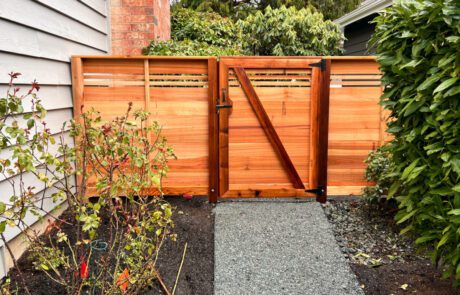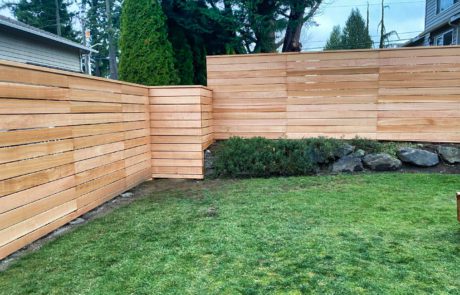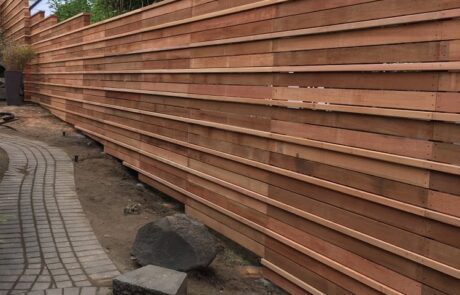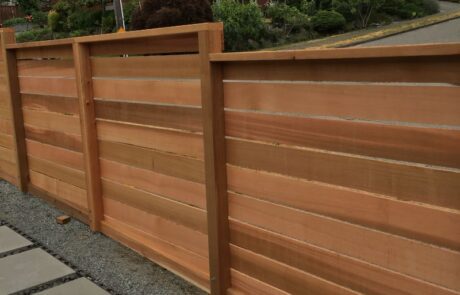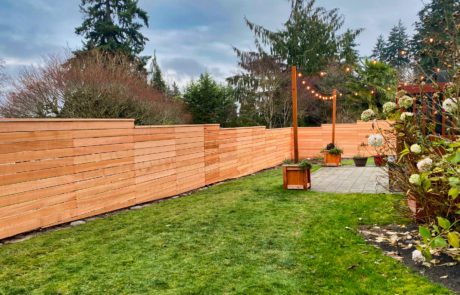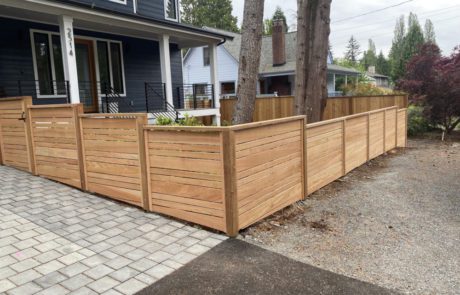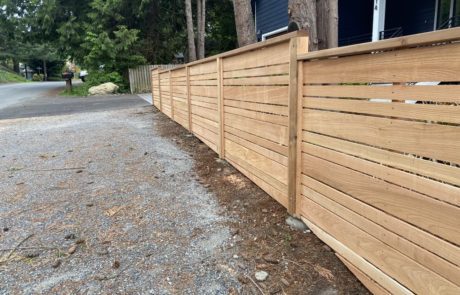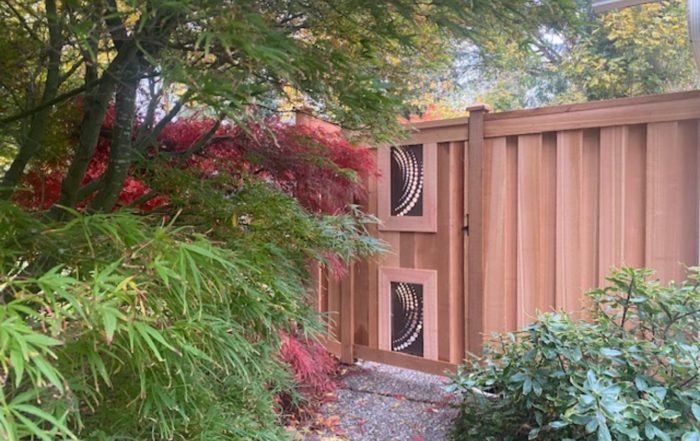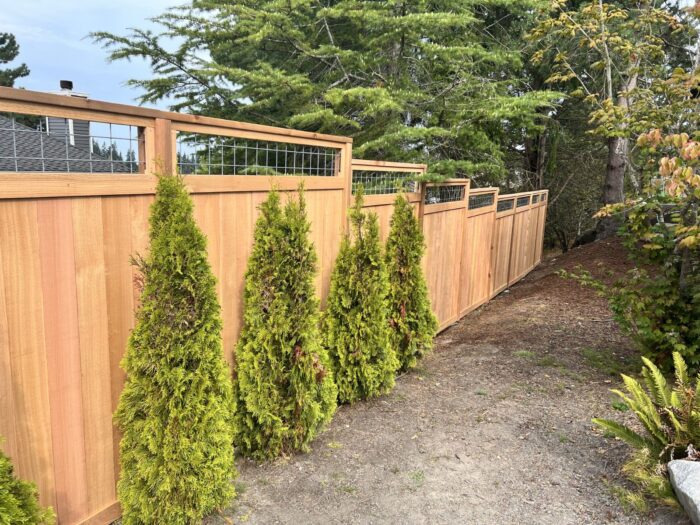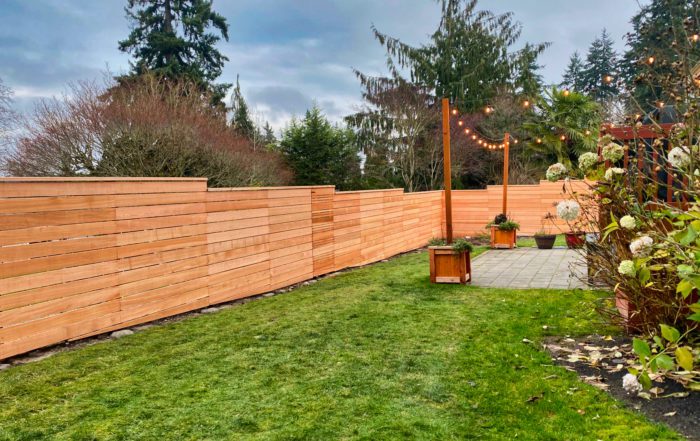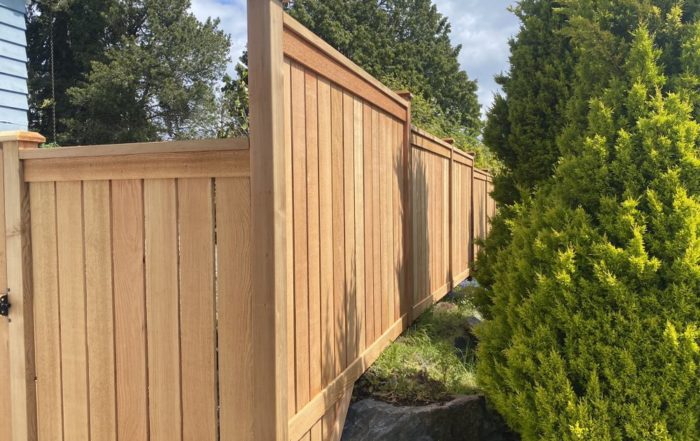Situated in Snohomish County, Washington, Edmonds is a city known for its unique charm and relaxed lifestyle. Part of preserving and enhancing this charm involves implementing specific development codes
Introduction
Situated in Snohomish County, Washington, Edmonds is a city known for its unique charm and relaxed lifestyle. Part of preserving and enhancing this charm involves implementing specific development codes, particularly Chapter 17.30, which lays out the community development code’s regulations and definitions for residential fences.
All codes and regulations listed below are current as of 2023.
Types of Fences Allowed in Edmonds
The City of Edmonds, Washington, doesn’t necessarily restrict the type of material used for fences, so you could use wood, vinyl, metal, or chain-link, as long as it adheres to specific guidelines and regulations.
Edmonds City Right-of-Way
Typically, fences are installed on private property in Edmonds. However, it’s important to note that private property lines may not always be clearly defined, especially when adjacent to undeveloped City streets without sidewalks. The boundaries of public streets are determined by the City’s Official Street Map, which takes precedence.
The city may or may not utilize the entire right-of-way for every street. Consult the Official City Street Map available in the City Engineering Division to find the street right-of-way and determine the extent of city property.
Please be aware that private fences should not be located within developed or undeveloped City right-of-way unless authorized by the City Engineer through a separate Encroachment Permit. It is recommended to seek approval and guidance from the City Engineer before placing a fence within the City right-of-way.
Fence Setbacks in Edmonds
If your fence is 6 feet tall or shorter, you have the option to place it right up to the property line as long as you meet the following requirements:
- Residential fences on a corner lot meet the vision clearance requirements stated in the section on height restrictions.
- A fence built on top of a retaining wall meets the 6-foot height requirement when measured on the uphill side of the slope.
- The fence is set back the width of any required landscaped area. If no landscaped area is required, they may be installed without a setback in the front, side, or rear yard.
If you plan to construct a site-obscuring fence or freestanding wall that exceeds 6 feet in height, it must comply with the required building setback for the city of Edmonds, which can be anywhere from 15 to 25 feet, depending on the circumstances. Refer to the table of site development standards listed in Chapter 16.20 Single-Family Residential for the latest requirements.
Utility Easements and Waterways
If you’re planning to build a fence over or next to utility easements, drainage courses, or waterways in Edmonds, there may be specific rules and conditions that apply. These areas are designated for utilities or water flow, so it’s important to take certain considerations into account.
To get more information about any special restrictions or requirements related to fences in these areas, we recommend reaching out to a City Engineering Technician.
Height Limit: How tall can your fence be?
In general, fences up to 6 feet high are allowed in the backyard, while fences in the front yard are typically limited to 4 feet. However, there are certain exceptions for properties next to commercial zones or major thoroughfares. To get an accurate height measure from the top of the fence to the ground level.
The transparency of fences, especially those on corner lots or in front yards, may also be regulated to maintain visibility for drivers and pedestrians in what the Washington State Department of Transportation calls a “sight triangle“.

Height Restrictions near Streets and Corners
The maximum height for a fence within 10 feet of a street or pathway or 30 feet of a corner is 3 feet. If your fence is taller than 3 feet and located within those limits, you’ll need a permit. Measure the height from the top of the fence down to the ground level. This ensures safety and clear visibility for everyone. However, there are exceptions to this rule if approved.
For example, imagine you want a slightly taller fence near the street or corner to enhance privacy. Normally, the limit is 3-feet, but if the city engineer determines that it won’t create any hazards for street users or neighboring properties, they may grant an exception for a fence up to 6-feet in height.
Approval of Exceptions
To obtain approval for a fence taller than 3 feet near streets or corners, the City Traffic Engineer will assess whether it poses any risks to people using the street or nearby properties. If they find no potential hazards, they may approve a fence up to 6 feet in height.
Prioritizing Safety
Safety is of utmost importance when it comes to fences. No fence or other obstruction should create hazards for street users or neighboring properties. This ensures the well-being and protection of everyone in the community.
Remember, these guidelines are in place to maintain safety and prevent accidents near streets and corners. If you have any questions or need approval for a taller fence, contact the city engineer for guidance.
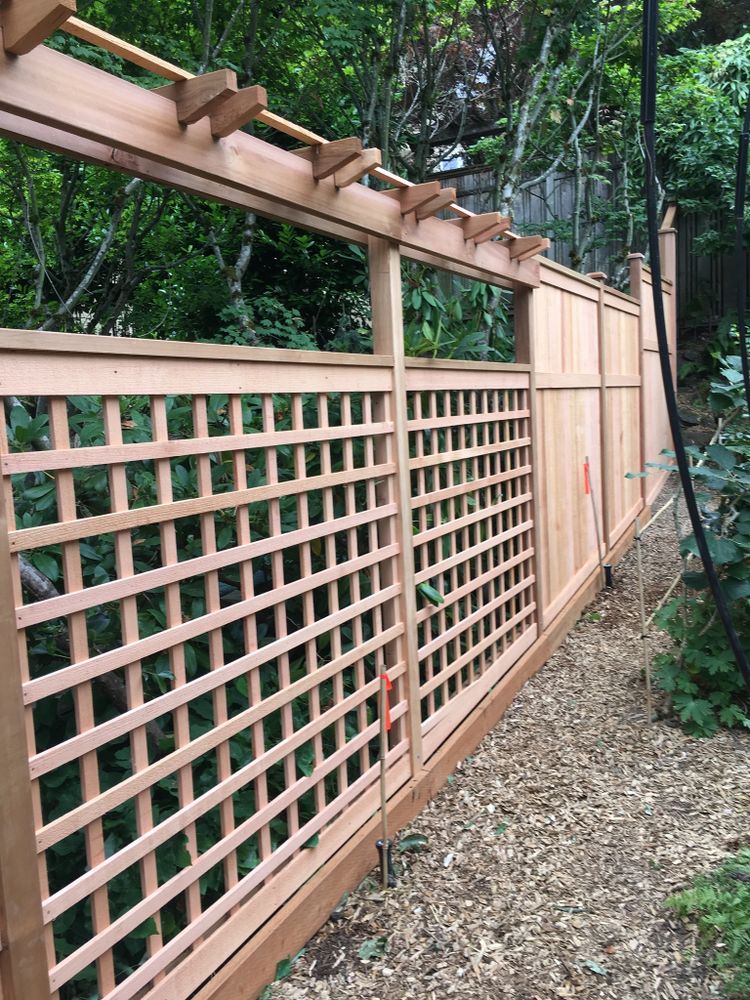
Trellises and Arbors: What You Need to Know in Edmonds
If you’re considering adding a trellis or arbor to your property in Edmonds, we’ve got you covered with some simple guidelines.
What are the Definitions?
Let’s define some important terms related to trellises and arbors:
Arbor: An arbor is a separate structure that can be freestanding or attached to a wall or gate. It features a roof and walls made of lattice or a horizontal latticework design. Arbors are often used to create beautiful entrances or gateways.
Trellis: A trellis is a horizontal structure featuring an open latticework design. It is specifically designed to support the growth of vines or other vegetation. It can also be used as a decorative element, allowing light and air to pass through.
Lattice and Latticework: Lattice or latticework refers to a decorative framework made of wooden or metal strips arranged in a cross pattern. It can also be an open framework designed to allow the free flow of light and air. These designs are primarily used for decorative or landscaping purposes.
Predominantly Open: Predominantly open describes latticework or similar decorative patterns that allow ample light and air to pass through. These designs prioritize aesthetics and are not intended for privacy or security purposes.
Trellis Fence Regulations
In the Edmonds Community Development Code, trellises are considered either a fence or a part of a fence. This means that they are subject to the same height limitations as regular fences. Just like fences, you’ll need to obtain permits for trellises under the same circumstances.
If your trellis has a horizontal element that measures more than thirty-six inches in width when measured perpendicular to the fence or trellis, it will be classified as an arbor. This means that the specific requirements for arbors, such as siting regulations, will apply.
Arbor Regulations
An arbor in Edmonds is considered an accessory structure and is subject to corresponding regulations. If the arbor is an accessory to a multifamily building and exceeds 120 square feet, a building permit is required. Similarly, if the arbor is an accessory to a single-family residence and exceeds 200 square feet, a permit is needed.
The height of the arbor should not exceed 15 feet. However, if the arbor is constructed over a gate, walkway, or entrance, it can be built an additional 3 feet taller than the fence height, which is limited to 6 feet. This means the maximum height for an arbor over a gate, walkway, or entrance is 9 feet.
Exceptions to the Height Restrictions
You have some freedom to add height to your fence with certain guidelines:
Decorative Trellis on Fence
You can add a decorative trellis to your fence, raising the height by up to 2 feet. The total height, including the trellis, should not exceed 8 feet. However, the combined length of all trellises on one property line should not exceed 25 percent of the total length of that property line.
Decorative Trellis Facing Street, Alley, or Access Easement
You can add a decorative trellis up to 2 feet in height, with a maximum total height of 8 feet, to a fence that faces a street, alley, or access easement. It’s important to ensure that the trellis remains free of any plantings, vegetation, or visual obstructions.
Arbor over Gate, Walkway, or Entrance
If you have a gate, walkway, or entrance, you can construct an arbor up to three additional feet in height, with a maximum total height of 9 feet.
By following these guidelines, you can create stunning trellises and arbors to elevate the beauty of your outdoor spaces. Remember to obtain the necessary permits when required to ensure compliance with the regulations. Enjoy transforming your property into a captivating oasis!
Critical Areas: Do you need a permit?
Yes, you’ll need a permit if your fence is in or near a critical area or its buffer zone. Critical areas include sensitive environmental zones like wetlands or habitats that require protection. Make sure to check if your property falls into one of these areas.
For example, if your backyard borders a serene marshland, and you plan to install a fence there. Even if it’s a short fence, you’ll need to obtain a permit.
Swimming Pools
For residential swimming pool fences in Edmonds, the minimum height required is 4 feet. The openings in the fence should be designed in accordance with Chapter 3 of the International Swimming Pool and Spa Code. This helps ensure the safety and security of the pool area.
Retaining Walls: Can your fence be taller near a retaining wall?
If you have a retaining wall that’s 3 feet tall or higher and it’s connected to your proposed fence, you can build the fence up to 4 feet above the top of the wall or the finished ground level—whichever is lower—for safety reasons. No variance is necessary for this.
For example, if you’re planning to construct a three-foot-tall retaining wall near your property line and you want to put a fence on top of it, you can make the fence 4 feet taller than the wall’s height without requiring a variance.
Obtaining Permits for Fences in Edmonds
- Research: Start by familiarizing yourself with the specific regulations for fences in Edmonds. Look for guidelines on height restrictions, setback requirements, and any other relevant rules. You can usually find this information on the city’s official website or by contacting the local building department.
- Plan your Fence: Determine the type of fence you want, its dimensions, and the exact location where you plan to install it. Having a clear idea of what you want will help streamline the permit application process.
- Fill out the Application: Obtain the necessary permit application form from the city’s building department or website. Fill it out accurately and provide all the required information. Make sure to include details about the materials you plan to use, the fence’s height, and its location on your property.
- Prepare Supporting Documents: Depending on the specific requirements of your project, you may need to submit additional documents along with your application. These could include a site plan, property survey, or even a design sketch of your proposed fence.
- Submit your Application: Once you have completed the application and gathered all the necessary documents, submit them to the building department. It’s a good idea to make copies for your own records.
- Pay the Fee: There is usually a fee associated with the permit application. Be prepared to pay this fee, which helps cover the administrative costs of processing your application.
- Await Approval: The building department will review your application and documents to ensure compliance with local codes. If any adjustments are needed, they will provide you with guidance and suggestions. Once everything is in order, you will receive your permit.
Note: If you have your fence professionally installed, most contractors will handle this process for you.
Glossary of Terms
- Fence Permit: This is the official permission granted by the city to construct or modify a fence. You often need a permit for fences over a certain height (usually 6 feet as of 2021).
- Property Line: This is the legally defined boundary that separates your property from your neighbor’s. It’s important to know exactly where this line is before you start building a fence.
- Setback: This term refers to the distance your fence needs to be from the street, sidewalk, or other public right of way. In Edmonds, the required setback can vary depending on the zone.
- Easement: This is a right held by someone other than the property owner to use a section of the property for a specific purpose, like utility lines. You usually can’t build a fence on an easement.
- Residential Zones: These are areas of the city designated for residential use, such as single-family homes, duplexes, and townhouses. Fence rules can vary by zone.
- Height Limit: The maximum height allowed for a fence.
- Sight Triangle: A clear sight area is required at intersections to maintain visibility for traffic safety. In these areas, fence heights are often restricted to 3 feet.
- Retaining Wall: A structure designed to hold back the soil. If a fence is placed on top of a retaining wall, the height of both structures combined must usually stay within the permitted fence height.
- Non-Conforming Fence: A fence that doesn’t meet current code regulations but was legal when it was built. Non-conforming fences are often allowed to remain until they’re replaced or significantly altered.
- Impervious Surface: Any surface that doesn’t absorb rainwater. Some areas have a limit on the number of impervious surfaces on a property, which could affect fence design.
- Variance: This is a formal request to deviate from current zoning requirements. If you want to build a fence that doesn’t comply with the standard regulations – say, a taller fence than is usually allowed – you might need to apply for a variance. Getting a variance approved can be a complex process. It usually requires showing that your property has unique circumstances and that your plan won’t negatively impact your neighbors or the community.
Resources:
City of Edmonds
City of Edmonds: Informational Handouts
City of Edmonds Permit Information, Forms, Fees
City of Edmonds Public Works Staff Directory
Edmonds City Code: Height Restrictions (17.30.010)
Edmonds City Code: Trellises and Arbors (17.30.35)
Edmonds City Code: Site Development Standards (16.20.030)
City of Edmonds Maps/Geographic Information System (GIS)
Snohomish County
City of Edmonds: Permit Submittal Requirements for Fences
Snohomish County Planning and Development Services: Assistance Bulletin – Fences
Washington State
Washington State property laws regarding fences
Snohomish County Planning and Development Services
Comprehensive Guide to Washington Fence Laws: Know Before Installing Your Fence
Washington State: Commonly Asked Questions About Sharing a Fence With Your Neighbors
Summary and Conclusion
In conclusion, understanding the rules and regulations surrounding fences, trellises, arbors, and retaining walls is essential when planning any construction or modification in your outdoor space. By following these guidelines, you can ensure the safety of yourself and others while creating a beautiful and functional environment.
Remember to obtain any necessary permits and approvals, adhere to height limitations, and prioritize safety at all times. Whether you’re adding a fence for privacy, constructing a trellis for plant growth, or incorporating an arbor as a stunning entrance, these regulations exist to maintain the integrity of the community and protect its members.
Contact the city engineer or relevant authorities if you have any questions or need guidance throughout your project. With careful planning and adherence to the guidelines, you can create a wonderful outdoor space that enhances the beauty and enjoyment of your property in Edmonds.
Frequently Asked Questions
What types of fences are allowed in Edmonds, Washington?
In Edmonds, Washington, you are not restricted to any specific type of material for fences. You can use wood, vinyl, metal, or chain-link as long as they comply with the guidelines and regulations set by the city.
How tall can my fence be in Edmonds?
Generally, fences in the backyard can be up to 6 feet high, while those in the front yard are typically limited to 4 feet. However, exceptions exist for properties adjacent to commercial zones or major thoroughfares. To get an accurate height measurement, you should measure from the top of the fence to the ground level.
Are there height restrictions for fences near streets and corners in Edmonds?
Yes, there are height restrictions for fences located within 10 feet of a street or pathway or within 30 feet of a corner in Edmonds. The maximum height allowed in these areas is 3 feet. You will need a permit if your fence exceeds 3 feet and falls within these limits. However, exceptions may be granted by the city engineer if it is determined to be safe and does not pose hazards to street users or neighboring properties.
What are the guidelines for trellises and arbors in Edmonds?
In Edmonds, trellises and arbors are subject to the same height limitations as regular fences. If your trellis has a horizontal element that measures more than thirty-six inches in width when measured perpendicular to the fence or trellis, it will be classified as an arbor. Specific requirements for arbors, such as siting regulations, will then apply.
Do I need a permit for my fence if it is located in or near a critical area in Edmonds?
Yes, if your fence is in or near a critical area or its buffer zone, you will need a permit in Edmonds. Critical areas include environmentally sensitive zones like wetlands or habitats that require protection. It is important to check if your property falls within these areas and obtain the necessary permit accordingly.
Will Sky Fence Company help with the permitting process?
Sky Fence Company understands the ins and outs of State, County, and City regulations. They will help clear up any confusion and handle the permitting process if needed.

